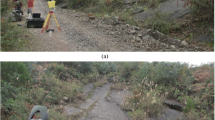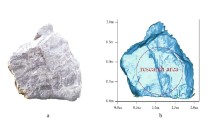Abstract
Accurately estimating rock joint roughness is crucial for understanding the shear mechanism and permeability behavior of a rock mass. Several influencing factors, including anisotropy, measurement noise, and the scale effect and sampling interval, have been considered. However, little attention is paid to the influences of nonstationary features on the roughness assessment. In this study, a portable laser scanner was employed to collect high-density 3D point clouds of ten natural rock joint specimens. Based on two parameters, namely, the bright area percentage (BAP) and θ*max/(C + 1), where θ*max is the maximum apparent dip angle and C is a dimensionless fitting parameter, the rock joint roughness was determined before and after removing nonstationary features, and a comparison showed that nonstationary features have a considerable influence on the roughness. Subsequently, an approach was proposed to remove nonstationary features through the conversion of spatial coordinates, and an application to a roughness evaluation illustrated that similar trends are observed between the BAP and θ*max/(C + 1) with respect to the point clouds of ten rock joints whose nonstationary features were removed. These findings reveal that nonstationary features should be removed to improve the accuracy and comparability of the roughness assessments.












Similar content being viewed by others
References
Babanouri N, Nasab SK, Sarafrazi S (2013) A hybrid particle swarm optimization and multi-layer perceptron algorithm for bivariate fractal analysis of rock fractures roughness. Int J Rock Mech Min Sci 60(60):66–74. https://doi.org/10.1016/j.ijrmms.2012.12.028
Barton N (1973) Review of a new shear-strength criterion for rock joints. Eng Geol 7(4):287–332. https://doi.org/10.1016/0013-7952(73)90013-6
Barton N, Choubey V (1977) The shear strength of rock joints in theory and practice. Rock Mech Rock Eng 10(1–2):1–54. https://doi.org/10.1007/BF01261801
Belem T, Etienne FH, Souley M (2000) Quantitative parameters for rock joint surface roughness. Rock Mech Rock Eng 33(4):217–242. https://doi.org/10.1007/s006030070001
Bitenc M, Kieffer DS, Khoshelham K (2016) Evaluation of wavelet and non-local mean denoising of terrestrial laser scanning data for small-scale joint roughness estimation. ISPRS-International Archives of the Photogrammetry Remote Sensing and Spatial Information Sciences. https://doi.org/10.5194/isprsarchives-XLI-B3-181-2016
Clark KC (1986) Computation of the fractal dimension of topographic surfaces using the triangular prism surface area method. Comput Geosci 12(5):713–722. https://doi.org/10.1016/0098-3004(86)90047-6
Du SG, Tang HM (1993) A study on the anisotropy of joint roughness coefficient in rock mass. J Eng Geol 1:32–42
Ge YF, Kulatilake PHSW, Tang HM, **ong C (2014) Investigation of natural rock joint roughness. Comput Geotech 55(55):290–305. https://doi.org/10.1016/j.compgeo.2013.09.015
Ge YF, Tang HM, Eldin MAME, Chen PY, Wang LQ, Wang JG (2015) A description for rock joint roughness based on terrestrial laser scanner and image analysis. Sci Rep 5:16999. https://doi.org/10.1038/srep16999
Ge YF, Tang HM, Eldin MA, Wang LQ (2017) Evolution process of natural rock joint roughness during direct shear tests. International Journal of Geomechnics 17(5). https://doi.org/10.1061/(ASCE)GM.1943-5622.0000694
Ge YF, Tang HM, **a D, Wang LQ, Zhao BB, Teaway JW, Chen HZ, Zhou T (2018) Automated measurements of discontinuity geometric properties from a 3D-point cloud based on a modified region growing algorithm. Eng Geol 242:44–54. https://doi.org/10.1016/j.enggeo.2018.05.007
Grasselli G, Egger P (2003) Constitutive law for the shear strength of rock joints based on three-dimensional surface parameters. Int J Rock Mech Min Sci 40(1):25–40. https://doi.org/10.1016/S1365-1609(02)00101-6
Jiang Q, Feng XT, Gong YH, Song LB, Ran SG, Cui J (2016) Reverse modelling of natural rock joints using 3D scanning and 3D printing. Comput Geotech 73:210–220. https://doi.org/10.1016/j.compgeo.2015.11.020
Khoshelham K, Altundag D, Ngan-Tillard D, Menenti M (2011) Influence of range measurement noise on roughness characterization of rock surfaces using terrestrial laser scanning. International Journal of Rock Mechanics and Mining Sciences 48(8):1215–1223. https://doi.org/10.1016/j.ijrmms.2011.09.007
Kulatilake PHSW, Shou G, Huang TH, Morgan RM (1995) New peak shear strength criteria for anisotropic rock joints. International Journal of Rock Mechanics and Mining Sciences and Geomechanics Abstracts 32(7):673–697. https://doi.org/10.1016/0148-9062(95)00022-9
Kulatilake PHSW, Balasingam P, Park J, Morgan RM (2006) Natural rock joint roughness quantification through fractal techniques. Geotech Geol Eng 24(5):1181–1202. https://doi.org/10.1007/s10706-005-1219-6
Li YC, Wu W, Li B (2018) An analytical model for two order asperity degradation of rock joints under constant normal stifness conditions. Rock Mech Rock Eng 1:1–15. https://doi.org/10.1007/s00603-018-1405-5
Luo ZY, Du SG, Huang M (2015) An experimental study of size effect of roughness coefficient on rock joint using push-pull apparatus. Rock Soil Mech 36(12):3381–3386. https://doi.org/10.16285/j.rsm.2015.12.006
Ma YX, Guo YL, Lei YJ, Lu M, Zhang J (2017) Efficient rotation estimation for 3D registration and global localization in structured point clouds. Image Vis Comput 67:52–66. https://doi.org/10.1016/j.imavis.2017.09.003
Maerz NH, Franklin JA, Bennett CP (1990) Joint roughness measurement using shadow profilometry. International Journal of Rock Mechanics and Mining Sciences and Geomechanics Abstracts 27(5):329–343. https://doi.org/10.1016/0148-9062(90)92708-M
Mah J, McKinnon SD, Samson C, Thibodeau D (2016) Wire mesh filtering in 3D image data of rock faces. Tunnelling and Undergeround Space Techology 52(10):111–118. https://doi.org/10.1016/j.tust.2015.11.005
Mlynarczuk M (2010) Description and classification of rock surfaces by means of laser profilometry and mathematical morphology. Int J Rock Mech Min Sci 47(1):138–149. https://doi.org/10.1016/j.ijrmms.2009.09.004
Nizametdinov FK, Nagibin AA, Levashov VV, Nizametdinov RF, Nizametdinov NF, Kasymzhanova AE (2016) Methods of in situ strength testing of rocks and joints. J Min Sci 52(2):226–232. https://doi.org/10.1134/S1062739116020357
Odling NE (1994) Natural fracture profiles, fractal dimension and joint roughness coefficients. Rock Mech Rock Eng 27(3):135–153. https://doi.org/10.1007/BF01020307
Tang HM, Wasowski J, Juang CH (2019) Geohazards in the three Gorges Reservoir Area, China-Lessons learned from decades of research. Eng Geol 261:105267. https://doi.org/10.1016/j.enggeo.2019.105267
Tatone BSA, Grasselli G (2009) A method to evaluate the three-dimensional roughness of fracture surfaces in brittle geomaterials. Rev Sci Instrum 80(12):125110. https://doi.org/10.1063/1.3266964
Tatone BSA, Grasselli G (2010) A new 2D discontinuity roughness parameter and its correlation with JRC. Int J Rock Mech Min Sci 47(8):1391–1400. https://doi.org/10.1016/j.ijrmms.2010.06.006
Tse R, Cruden DM (1979) Estimating joint roughness coefficients. International Journal of Rock Mechanics and Mining Sciences and Geomechanics Abstracts 16(5):303–307. https://doi.org/10.1016/0148-9062(79)90241-9
Turk N, Greig MJ, Dearman WR, Amin FF (1987) Characterization of rock joint surfarces by fractal dimension. The 28th U.S. Symposium on Rock Mechanics 28:1223–1236
Wu TH, Ali EM (1978) Statistical representation of joint roughness. International Journal of Rock Mechanics and Mining Sciences and Geomechanics Abstracts 15(5):259–262. https://doi.org/10.1016/0148-9062(78)90958-0
**e HP, Wang JA, Stein E (1998) Direct fractal measurement and multifractal properties of fracture surface. Phys Lett A 242:41–50. https://doi.org/10.1016/s0375-9601(98)00098-x
Yu XB, Vayssade B (1991) Joint profiles and their roughness parameters. International Journal of Rock Mechanics and Mining Sciences and Geomechanics Abstracts 28(4):333–336. https://doi.org/10.1016/0148-9062(91)90598-G
Acknowledgments
The authors are grateful to Liangqing Wang and Yi Cai for their help in data sampling and processing. Special thanks are owed to Yuhang Ren and Jenkins Wholda Teaway for their English language editing services. The authors also thank the editors and anonymous reviewers for their insightful and valuable suggestions.
Funding
This research was funded by the National Key R&D Program of China (No. 2017YFC1501303 & 2018YFC1507200) and the National Natural Science Foundation of China (No. 41602316).
Author information
Authors and Affiliations
Corresponding author
Additional information
Highlights
(1) The effects of nonstationary features on rock joint roughness were investigated.
(2) An approach for removing the nonstationary features of a rock joint was proposed.
Rights and permissions
About this article
Cite this article
Ge, Y., Lin, Z., Tang, H. et al. Investigation of the effects of nonstationary features on rock joint roughness using the laser scanning technique. Bull Eng Geol Environ 79, 3163–3174 (2020). https://doi.org/10.1007/s10064-020-01754-6
Received:
Accepted:
Published:
Issue Date:
DOI: https://doi.org/10.1007/s10064-020-01754-6




